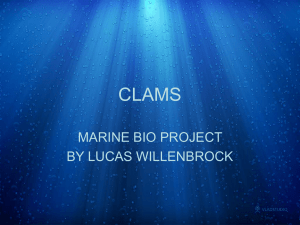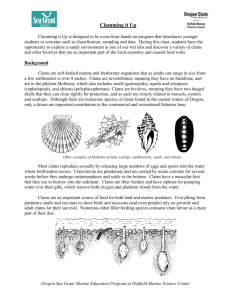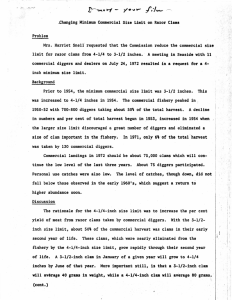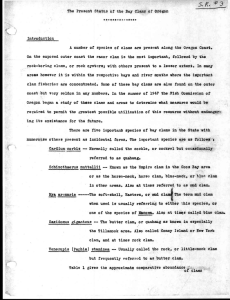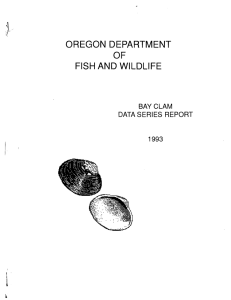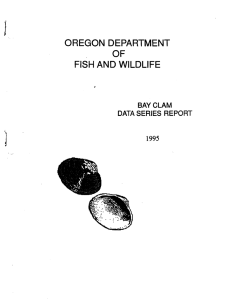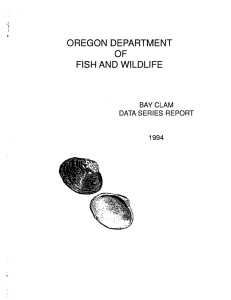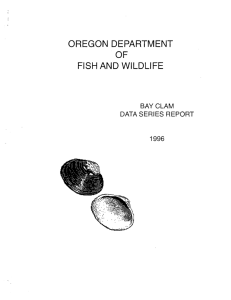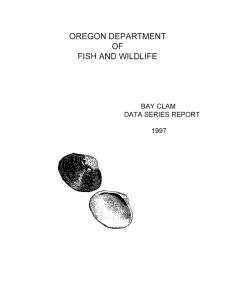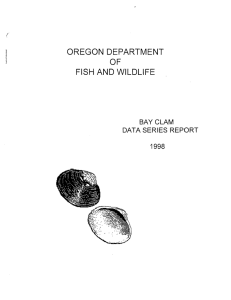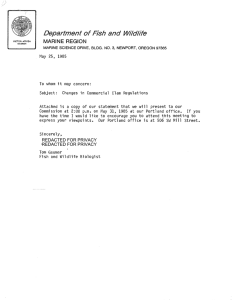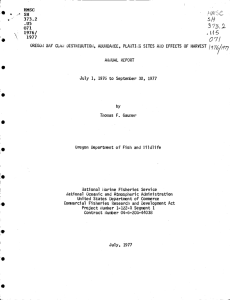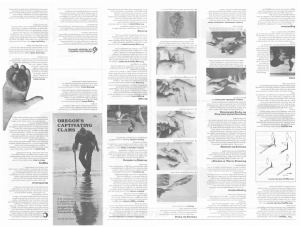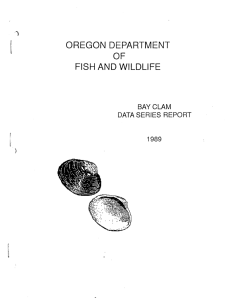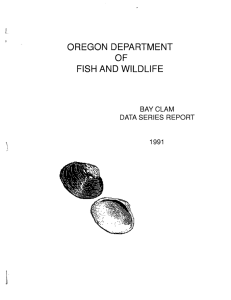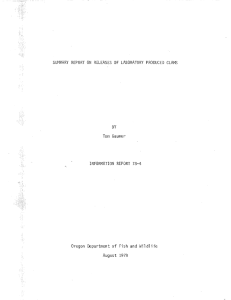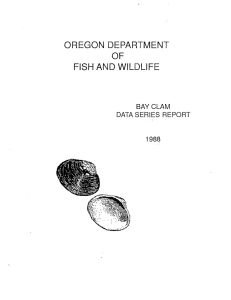o r
advertisement
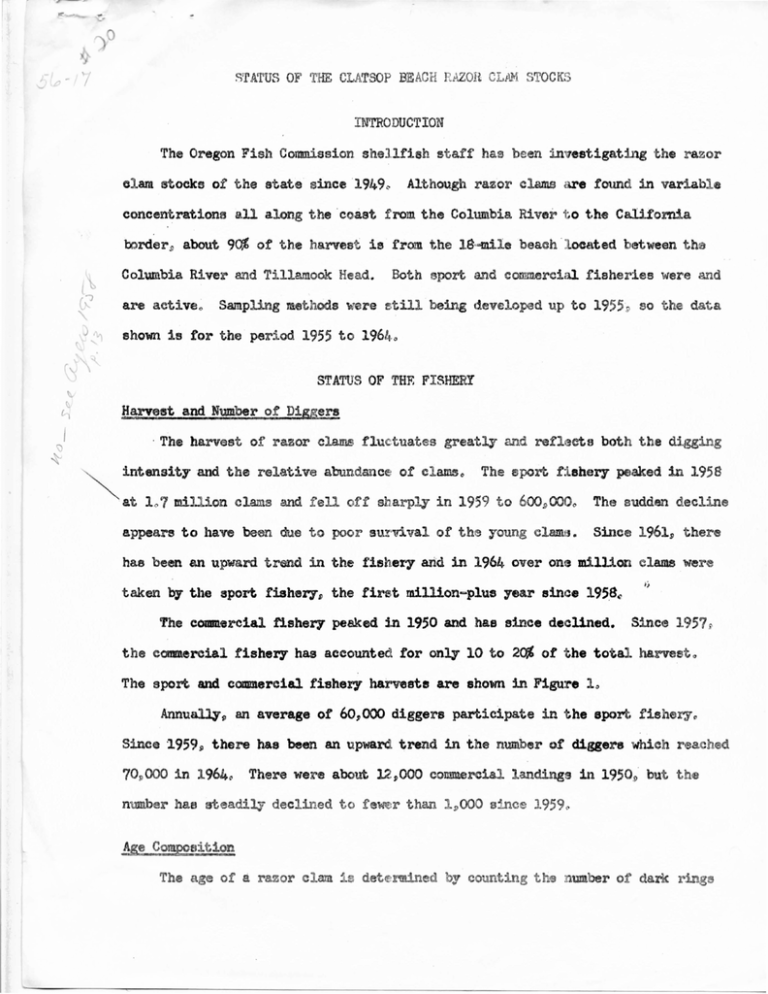
~TATUS OF C ATSOP BEACH ffi ~20R CLAM STOCK~ INTRODUCTION The Oregon Fish Commission shellfish staff ha5 been in eetigating the r azor cl am stocks or the state since ·1949 ~ Although razor clams are foun concentrations all along the ·coast f rom the Columbia River .! o the Califomia 1x>rderSl about 9tJI, of the harvest is from the 184ni.le beach · ocated Columbia River and Tillamook Head. are active ~ Sampling methods shown is for the period re Both in variabl e etween t he port and commercial fisheries were and till being developed up to 1955 so the data 1955 to 1964o STATUS OF THF. FI SHERY ~arvest and Number of Diggers · The harvest of razor clams fluctuates greatly and refl ets both the digging intensity and the relative a.bundanc at 1 7 mil ion clams and fell of cla.ms o The f~ po1"t ehery ff s arply in 1959 to 600 9 000o appears to have been due to poor surrlval of th Th young clam • Sine aked in 1958 sudden declin 1961.9 t her has been an upwa rd trend in the fis hery arid in 1964 over one million clams wer.a taken b;y the sport fishery~ the fir t million-plus year since 195.8~ The commercial tlehery peaked in 1950 and has since declined. Since 1957 the conmercial f'isheey has accounted tor only 10 to 20% of the total harv et o The sport. and caamercial fisheey harvests are ehown in Figure lo Annuall.y~ an average Since 1959~ or 60,000 diggers participate in the sport fis hery" there has been an upward. trend in the number or 701) 000 in 1964" There were about 12,000 commercial landing numb hae t adily declined to f r than 1:>000 inc diggers whic reach d in 1950 · but t 1959 Age Composi ion The a or a razor clam d t .rmin by c unting t e um r of dark rin l/1 1.6 1.5 1,4 1.3 l 1.2 \oE- Spo1-t 1.1 m m r-i 0 ft..t 0 m a 1.0 0.9 Oo8 ...t r-t M .,... 0. 7:. ~ 0. 6 - \ Oo5 0.,4 0.3 0.2 o.: L 55 Figur e 1. 56 57 58 59 62 63 64 Y~ar Sport and Commercial Harvest of Razor Clams from Clat.sop Beach, 1955.._,1964o on the sh19llo Ra zor el&ms i n length by wint®r. epa;~~-n During the in .'~ he spr i ng or StJ »illle r ana. are about one inch complete calendar year to the ne~~ c lam~s second wintarj) it ia designated as a 0+ clam and l'lill aver age 3=3/4 inches in length. During the elams second ~rlnter, the first visible dark ring is formed and i t is designated as a 1+ elam» and so on up to age 5 v.rhich is generally the maxim m for· Ciatsop Beacho The age composition of the sport dug clams sho'!?:'S that 70 to 80'% of th.e· clam.a dug each year 0+ and 1+ ~re olam.S·. to the next year., 1964, 58% were 0+ clanw~ and there is ver,y little carr,y=ever of ~arg~ In 1962» 35~~ of the aport catch were 0+ ~lams and ,'in clama~ The commercial fiahe:ry on the o ;her hand is resstrieted to clams that ar·"' at l,ast 4=1/4 inches in length$) whi h eliminates emall clams from the fishery4' UTILIZATION OF CLfu~ STOCKS The number of razor clams harvested has shown a euat~d.ned increas~ si11tee . 1961~. However$ the r~sourc~ has been subject to em yield standpoint in two respects: Ut.!>).d~s irable (1} the discarding of broken and small cl ams (-.'"3-stage ) _and · (2 ) har--J"est of small claro.s.. Annual]:y, from 3 7.$) 000 to_Lqp.,OOO clams ar~~ wasted . and 57 ~000 to 635 ~000 small clams are dug.. ie now more seriouso ueage from a In general~ the problem In 1964~ over 242~000 clams were ~~stedp 2=1/2 times great= er t~an in 1963 and 1=1/2 ·t.imes gre&ter tho.n the 1957 to 1963 average., Also~ ov~r 6.35.o000 mnall clams (1 to .3=1/2 inches) were dug in 19641' 1=1/2 times gr eater tha~ · :'-tt --. · 1.96.3 and 2 t.imes greater th~"'l the 1957 to 1963 averag~Q The problem is most serioue between July 15 and August 3lo D&rl'el Demory j) Aquatic Biologist Oregon Fish Commission Research Division September 1965
